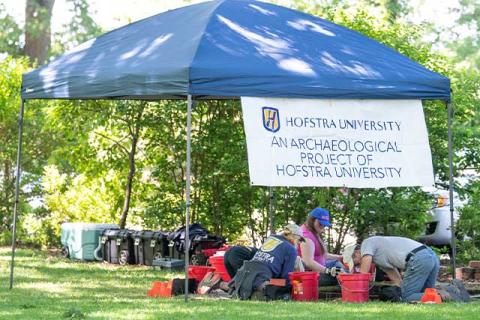
Rock Hall
The glass bottles, tobacco pipe stems, buttons, ceramic fragments and animal remains unearthed at Rock Hall Museum reveal a compelling story, and Hofstra University anthropology students are proud to help tell it.
The recovered items are reminders of a chapter in Long Island history not often discussed: The region was once home to a sizable slave population.
“It’s been really exciting to begin piecing together the history of the people who lived here,” said anthropology major Autumn Christopher. “It’s a history that wasn’t reflected in town and census records. Slavery on Long Island and in New York is not talked about much. I’m glad to be a part of helping to get the word out.” Read more about Rock Hall

King Manor
Up to their knees in dirt, students spent time digging in the ground of King Manor in Jamaica, Queens, the home of a New York State senator and delegate to the Constitutional Convention in 1787. Three seasons of archaeological excavation and analysis at the Rufus King Manor site were completed by Hofstra University between 2004 and 2006. This fieldwork was designed and directed by Dr. Christopher N. Matthews, former Associate Professor of Anthropology and past Executive Director of the Center for Public Archaeology. Field and laboratory research was supported by Hofstra University faculty and students as well as community volunteers. Get more info about King Manor

Lloyd Manor
A team of Hofstra faculty and students excavated a Lloyd Harbor site believed to be an 18th century slave quarter. Owned and maintained as a house museum by the Society for the Preservation of Long Island Antiquities, Joseph Lloyd Manor is a high-style Georgian house built in 1767. Lloyd Manor was also home to Jupiter Hammon, one of the first captive Africans to have his poetry published in the United States. Archaeological research at Lloyd Manor has focused on a historic outbuilding illustrated with a chimney on an 1814 map of the area. This outbuilding stood away from the manor house and was likely home to several captive Africans known to have lived at the site. CfPA’s excavations aimed to verify this and understand the larger community of captive Africans on Long Island. Learn more about Lloyd Manor

A Long Time Coming: Archaeology and History of the Native and African-American Community of Setauket (Jacob and Hannah Hart Site)
This field school program was based at the Jacob and Hannah Hart site, a home site occupied from ca. 1870 - 1930 by one of the community's most well-known families. Students worked with community members to survey, excavate, and analyze the findings from one of the few communities where African-Americans and Native Americans have lived together for generations and continue to live. Learn more at Newsday.com
Thompson House
The Thompson House in East Setauket, New York, has a rich and storied past. Built in the early 18th century, the house was home to multiple generations of the Thompson family, many of whom found their way into the annals of local history. Though the Thompson family’s contributions to local history are significant and meaningful, current research at the site is interested as well in people whose everyday practices are often overlooked - the enslaved Africans who lived and labored at the Thompson house. The descendant community actively countered their historical marginalization by collaborating with archaeologists to recover aspects of their heritage in the village. This research has developed a counter-narrative that not only returns non-whites to historic white spaces, but explains how non-whites were removed from these spaces through a process of segregation tied to the creation of a leisure economy.
Archaeology Lab
The archaeology laboratory is a menagerie of specific tools, instruments, and artifacts all contained into an organized workspace. Although field excavations are usually seen as the exciting part of the scientific process, the pre-excavation planning/logistics and the post excavation analysis are all conducted right here. It is truly in this room that the real discoveries are made. After an excavation, artifacts are analyzed, researched, and catalogued as a broader picture of forgotten past events are uncovered. Archaeology is sometimes painstaking and complicated but we try to make the process fun any way we can!
Publications
- Phillippi, Bradley D., and Christopher N. Matthews. "A counter-archaeology of labor and leisure in Setauket, New York." World Archaeology (2017): 1-15.
- Matthews, Christopher N. "11W How history controls the past® Discovering the unconventional and." Archaeologies of “Us” and “Them”: Debating History, Heritage and Indigeneity (2017): 100.
- Matthews, Christopher N. "Unconventional Archaeologies in Setauket, New York." Anthropology Now 5.2 (2013): 26-34.
- Matthews, C. "Emancipation landscapes: Archaeologies of racial modernity and the public sphere in early New York." Archaeology and the importance of material things 2 (2012): 63-92.
- Matthews, Christopher N. "Lonely islands: culture, community, and poverty in archaeological perspective." Historical Archaeology 45.3 (2011): 41-54.
- “The Archaeology of Captivity and Freedom in Early New York” – Hofstra Horizons, November 2007
- Matthews, Christopher N., Mark P. Leone, and Kurt A. Jordan. "The political economy of archaeological cultures: Marxism and American historical archaeology." Journal of Social Archaeology 2.1 (2002): 109-134.

